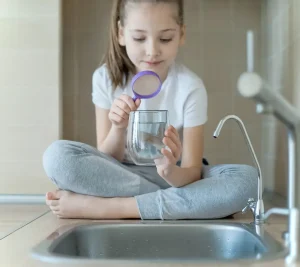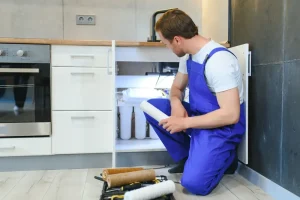Unlocking Pure Water: Understanding RO Systems - Aqua Hygiene UAE

Water is the eternal solvent of life. But as our water sources get dirtier, we need more powerful filter systems that are also easy to use. Here come Reverse Osmosis (RO) systems, a quiet fighter in the war for clean water. This detailed guide explains how RO systems work and gives you the information you need to decide if this method is the best way to keep your water safe.
 What is reverse osmosis, and how does it clean water?
What is reverse osmosis, and how does it clean water?
At its core, a reverse osmosis system cleans water through a semi-permeable filter that stops contaminants and lets H2O molecules pass through. The process includes putting pressure on the water on one side of the membrane, which makes it move against its natural flow. The word "reverse osmosis" comes from the fact that most molecules pass through the membrane while the contaminants stay behind.
Different kinds of RO systems can be used at home.
No one size fits all when it comes to RO systems. These are the main differences:
Traditional RO Systems: Traditional RO systems have a tank that stores clean water whenever needed.
Tankless RO Systems: These systems don't store water, so you always get fresh, filtered water. They are also called "direct flow" systems.
What's the Difference Between RO Systems with Tanks and Systems Without Tanks?
Tank-based RO water purifier systems keep filtered water in a tank to always be ready to use. On the other hand, tankless systems don't have a tank, so they only make water as needed. Your choice depends on how much space you have, how often you use it, and how fresh you like your water. Either way, you'll get good filtration.
 How Do Reverse Osmosis Systems Compare to Other Drinking Water Filters?
How Do Reverse Osmosis Systems Compare to Other Drinking Water Filters?
To understand how great RO systems are, it's essential to compare them to similar technologies from the same time:
Reverse Osmosis (RO) Systems:
RO filters are one of the best ways to treat water at home because they can eliminate many contaminants.
Ultrafiltration (UF) Systems:
UF is better at getting rid of germs, viruses, and some larger particles than RO, but it's not as good at getting rid of dissolved solids.
Activated Carbon Filters:
Carbon filters make water taste better and eliminate common impurities like chlorine, volatile organic compounds (VOCs), and herbicides. However, they might only be able to catch some of the minerals and dissolved solids that RO systems can.
Ultraviolet Light (UV):
UV is not a screen; it kills germs. It's often used with filtration devices to eliminate viruses, bacteria, and other harmful things that filters might miss.
Which toxins are the most common ones that RO systems can eliminate?
A reverse osmosis filter eliminates many contaminants, such as heavy metals and pesticides. Some of the main enemies that a RO system fights are:
- Sediment
- Chlorine
- Total dissolved solids
- Barium
- Cadmium
- Hexavalent and trivalent
- Chromium
- Lead
- Copper
- Radium 226/228
- Selenium
- Fluoride
- Nitrate/nitrite
However, it's worth mentioning that some RO systems can come with extra screens to help remove specific contaminants. This shows how flexible this method is.
What should you consider when picking a reverse osmosis system for your home or business?
Finding the right RO system is a lot like finding a match: you need to look at both short-term and long-term benefits. To help you, here is a list:
Tank Size and Number of Stages: This could change based on the size of your family, how much water you use, and how harmful the pollution is. More steps usually mean better filtration but are more challenging to set up and keep up.
Usage Volume: A system with a lot of output might not work well in a small home, and a system with less output might not work well in a place with a lot of demand.
Waste-to-Water Ratio: Some RO systems can make a lot of garbage during purification. This problem can be lessened with more advanced models.
How often do you need to maintain a RO system?
Maintaining an RO system is very important for keeping it working well:
Changing the filter often
To prevent sediments and chlorine from entering the RO membrane, pre-filters should usually be changed every 6 to 12 months. If the water could be better, the RO filter might need to be changed every two to three years.
Draining and cleaning the tank
Draining and sanitizing the whole system regularly is recommended to prevent germs from growing in the storage tank. This regular task is just as important as changing the filters, and it can happen simultaneously at every service interval to make maintenance go more smoothly.
Look-overs and Leak Checks
Keep an eye out for leaks or other problems with your RO system to ensure it keeps working as it should and doesn't waste water or let contaminants through.
Is a Reverse Osmosis System Right for You?
Before buying an RO system, it is essential to consider whether it fits your goals for clean water, lifestyle, and environmental concerns. Here is a self-evaluation to help you:
What Do You Want Your Water To Do For You?
Is your goal to eliminate all the contaminants or make the food taste and smell better? If you're primarily interested in pathogens, UV devices might be better.
Environmental Stance:
RO systems have been examined closely because they waste water, but newer types are made to be more efficient. If protecting the environment is necessary, looking into new types or different water filter methods could be the best option.
Water Quality Reality
The easiest way to see why reverse osmosis is needed is to test the water quality. If the water source has a lot of dissolved solids, heavy metals, or specific contaminants that RO is very good at getting rid of, it might be the best choice.
 Last Thoughts
Last Thoughts
Reverse osmosis systems are the best way to clean water because they combine the best features of complete filtration with ease of use in homes. You can get the most out of RO and write a part of your life's story about pure hydration if you understand how it works and look at your situation. Pure water is essential to life, whether from a nature reserve's mineral-rich streams or your kitchen faucet. With Aqua Hygiene RO, you're one step closer to that pure experience.


 What is reverse osmosis, and how does it clean water?
What is reverse osmosis, and how does it clean water? How Do Reverse Osmosis Systems Compare to Other Drinking Water Filters?
How Do Reverse Osmosis Systems Compare to Other Drinking Water Filters?
 Last Thoughts
Last Thoughts